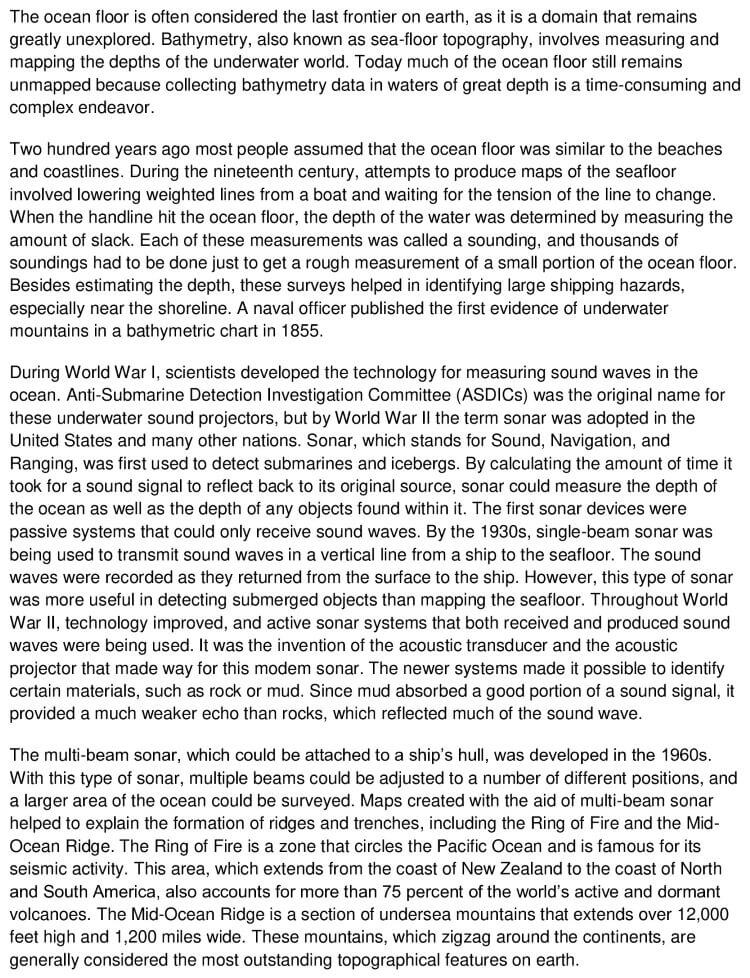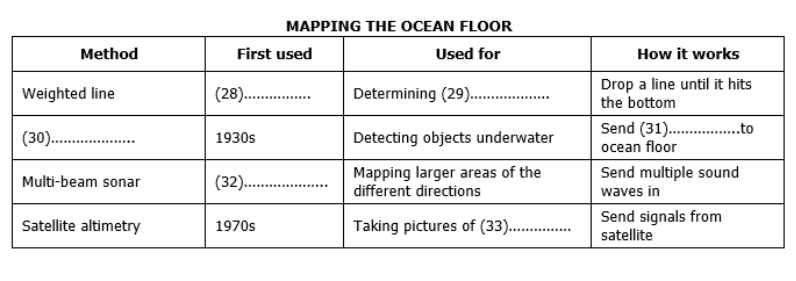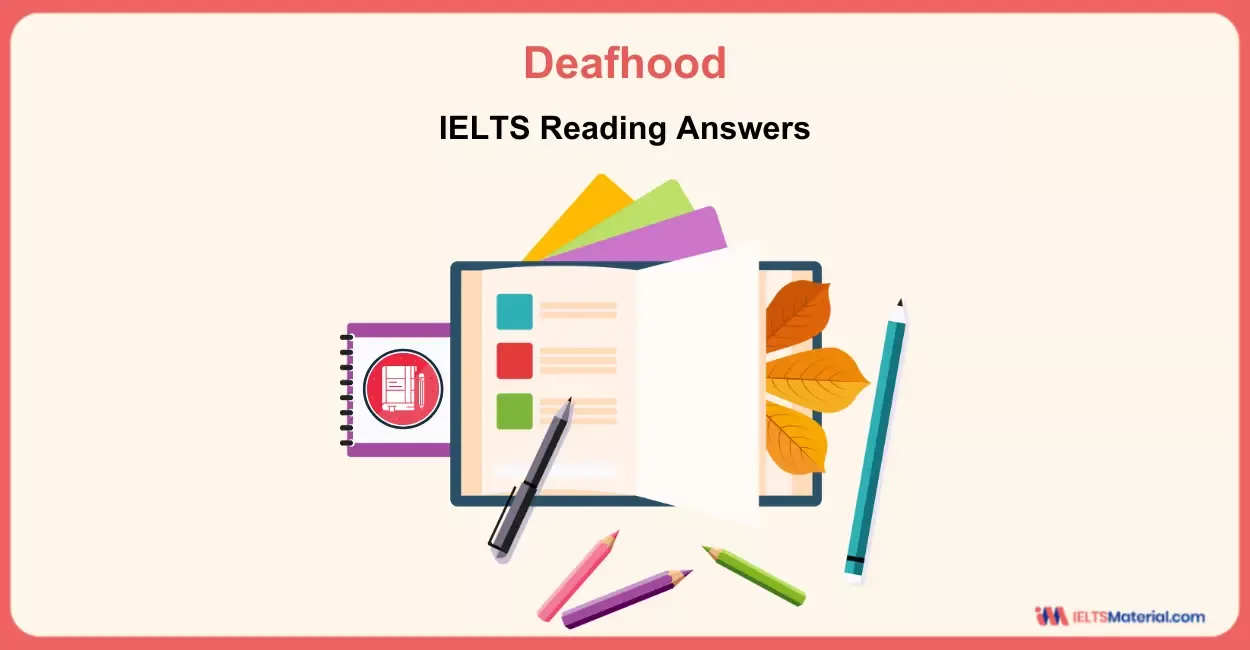Bathymetry - IELTS Reading Answers
10 min read
Updated On
-
Copy link
Test your reading skills with Bathymetry IELTS Reading Answers to achieve your desired IELTS score 9. Learn how to approach various IELTS reading questions & improve your reading strategy by looking at the answer explanations for this particular passage.
Table of Contents

Limited-Time Offer : Access a FREE 10-Day IELTS Study Plan!
Many IELTS candidates lose marks in the reading section for reasons that are totally avoidable, like not reading instructions carefully, getting stuck on one question, or misinterpreting the passage. However, these mistakes can be fixed if you take up passages like Bathymetry IELTS Reading Answers, from IELTS recent actual tests for regular practice.
In this blog, we will solve the passage, Bathymetry Reading Answersand provide explanations, locations for the answers, and tips to help you reduce careless mistakes.
Reading Passage for Bathymetry IELTS Reading
The ultimate step to resolving the questions from this passage is to go through the Bathymetry reading passage below. By doing so, you will improve your focus and accuracy, and build better reading habits, important for a high IELTS band score. Let’s get started!
You should spend about 20 minutes on Questions 1-13, which are based on the Reading Passage below.
Bathymetry


Questions for Bathymetry Reading Answers
The passage, Bathymetry Reading Answers, consists of 13 questions, which showcase three different IELTS Reading question types. As a result, you will be acquainted with different IELTS Reading question types with examples.
Here the question types in the reading test are:
- IELTS Reading Table Completion (Q. 28 - Q.33)
- IELTS Reading Matching Features (Q. 34 - Q. 37)
- IELTS Reading Multiple Choice Questions (Q. 38 - Q. 40)
Questions 28-33

Questions 34-37
Match each description below with the ocean region that it describes. In boxes 34-37 on your Answer Sheet, write
A. if it describes the Ring of Fire
B. if it describes the Mid-Ocean Ridge
34 It is known for the earthquakes that occur there.
35 It is over one thousand miles wide.
36 It is a mountain range.
37 It contains the majority of the earth’s volcanoes.
Questions 38-40
The list below gives some possible reasons for mapping the ocean floor.
Which THREE of these reasons are mentioned in the reading passage?
Write the appropriate Roman numerals i-vi in boxes 38-40 on your answer sheet.
i. Predicting earthquakes
ii. Finding new fuel resources
iii. Protecting ocean life
iv. Understanding weather patterns
v. Improving communications systems
vi. Improving the fishing industry
Looking for IELTS experts to interact with and learn from?
Don't miss out on the limited seats for the IELTS online webinars!
Bathymetry IELTS Reading Answers with Location and Explanation
Now, make sure your answers to the IELTS Academic Reading questions from the passage, Bathymetry, match the answers in the answer key given below. To make it easier to find, each answer's location and explanation are provided within the passage.
28 Answer: 19th century
Question type:Table Completion
Answer location: Paragraph 2,line 2
Answer explanation: The 2nd line of the 2nd paragraph states that during the nineteenth century, attempts to produce maps of the seafloor involved lowering weighted lines from a boat and waiting for the tension of the line to change. We can understand from these lines that the weighted lines were first used in the 19th century. Hence, the answer is the 19th century.
29 Answer: depth
Question type: Table Completion
Answer location: Paragraph 2,line 3
Answer explanation: The 3rd line of the 2nd paragraph states that when the handline hit the ocean floor, the depth of the water was determined by measuring the amount of slack. It is evident from these lines that the weighted line was first used in the 19th century, which was used for determining depth. Hence, the answer is depth.
30 Answer: single beam sonar
Question type: Table Completion
Answer location: Paragraph 3, line 6
Answer explanation: The 6th line of the 3rd paragraph states that by the 1930s, single-beam sonar was being used to transmit sound waves in a vertical line from a ship to the seafloor. We can deduce from these lines that by the 1930s, the single-beam sonar was used to detect the objects underwater. Hence, the answer is single beam sonar.
31 Answer: sound waves
Question type: Table Completion
Answer location: Paragraph 3, line 6
Answer explanation: Paragraph 3, line 6 states that by the 1930s, single-beam sonar was being used to transmit sound waves in a vertical line from a ship to the seafloor. The sound waves were recorded as they returned from the surface to the ship. These lines indicate that by the 1930s, the single-beam sonar was used to detect the objects underwater, that’d send the sound waves to the ocean floor. Hence, the answer is sound waves.
32 Answer: 1960s
Question type: Table Completion
Answer location: Paragraph 4
Answer explanation: The introductory lines of paragraph 4 states that the multi-beam sonar, which could be attached to a ship’s hull, was developed in the 1960s. These lines suggest that during the 1960s, the multi-beam sonar was used for mapping large areas in different directions and sending multiple sound waves. Hence, the answer is the 1960s.
33 Answer: entire globe/ earth
Question type: Table Completion
Answer location: Paragraph 4
Answer explanation: Paragraph 4 illustrates that the benefit of using satellites to map the ocean is that they can take pictures of the entire globe, including areas that have not yet been measured by sonar. These lines indicate that by the 1970s, satellite altimetry was used to take pictures of the entire globe/ earth to send signals from satellites. Hence, the answer is the entire globe/ earth.
34 Answer: A
Question type: Matching Features
Answer location: Paragraph 4, line 5
Answer explanation: The 4th line of paragraph 5 states that the Ring of Fire is a zone that circles the Pacific Ocean and is famous for its seismic activity. This area, which extends from the coast of New Zealand to the coast of North and South America, also accounts for more than 75 percent of the world’s active and dormant volcanoes. These lines indicate that the ring of fire is generally known for earthquakes (seismic activity) that occur there. Hence, the answer is A.
35 Answer: B
Question type: Matching Features
Answer location: Paragraph 4, line 6
Answer explanation: The 6th line of paragraph 4 states that the Mid-Ocean Ridge is a section of undersea mountains that extends over 12,000 feet high and 1,200 miles wide. These mountains, which zigzag around the continents, are generally considered the most outstanding topographical features on earth. It is evident from these lines that the mid-ocean ridge was over one thousand miles wild. Thus, the answer is B.
36 Answer: B
Question type: Matching Features
Answer location: Paragraph 4,line 6
Answer explanation: The 6th line of paragraph 4 states that the Mid-Ocean Ridge is a section of undersea mountains that extends over 12,000 feet high and 1,200 miles wide. These mountains, which zigzag around the continents, are generally considered the most outstanding topographical features on earth. It is evident from these lines that the mid-ocean ridge was over one thousand miles, which is a mountain range. Hence, the answer is A.
37 Answer: A
Question type: Matching Features
Answer location: Paragraph 4, line 5
Answer explanation: The 4th line of paragraph 5 states that the Ring of Fire is a zone that circles the Pacific Ocean and is famous for its seismic activity. This area, which extends from the coast of New Zealand to the coast of North and South America, also accounts for more than 75 percent of the world’s active and dormant volcanoes. These lines indicate that the ring of fire is generally known for earthquakes (seismic activity) that occur there and it contains the majority of the earth’s volcanoes. Hence, the answer is A.
38 Answer: ii
Question type: Matching Information
Answer location: Paragraph 6, line 2
Answer explanation: The 2nd line of paragraph 6 states that Scientists expect bathymetry to become one of the most important sciences as humans search for new energy sources and seek alternate routes for telecommunication. We can understand from these lines that one of the possible reasons for mapping the oceans is finding new fuel resources. Hence, the answer is ii.
39 Answer: iii
Question type: Matching Information
Answer location: Paragraph 6, last line
Answer explanation: The last line of the 6th paragraph states that Preserving the ocean’s biosphere for the future will also rely on accurate mapping of the seafloor. It is evident from these lines that protecting the ocean’s life (biosphere) in the future will depend on the accurate mapping of the seafloor. Hence, the answer is iii.
40 Answer: v
Question type: Matching Information
Answer location: Paragraph 6, line 2
Answer explanation: The 2nd line of the 6th paragraph states that Scientists expect bathymetry to become one of the most important sciences as humans search for new energy sources and seek alternate routes for telecommunication. We can deduce from these lines that the scientists are in search of new energy sources, simultaneously seeking alternate routes for telecommunications. Hence, the answer is v.
Tips for Answering the Question Types in Bathymetry IELTS Reading Answers
Now that you have the answers and explanations for Bathymetry Reading Answers, let's explore some IELTS exam preparation tips for band score of 8+ and answering the three question types.
Table Completion
- Scan for headings and column cues: Use the column headings (‘Method’, ‘First used’, ‘Used for’, ‘How to work’) as a guide. These act as keywords that help locate relevant sections quickly. You can underline or note down method names like ‘Weighted line’, ‘Echo sounding’, ‘Satellite altimetry’ in the passage.
- Pay attention to time markers: Phrases like ‘In the 1930s’, ‘first used in the 1970s’, or ‘recently developed’ often signal where answers for the 'First used' column are located. Also remember that for dates, only write the exact year or phrase, e.g., ‘1970s’, not ‘in the 1970s’.
- Look for synonyms in the text: The passage might not use the exact wording as in the question table. For example, if the table says, ‘Used for detecting objects’, the passage might say ‘identify sunken ships or debris’. So, match the meanings, not just words and use your IELTS vocabulary skills to recognize paraphrasing.
- Understand the process described: The ‘How to work’ column usually explains a method. These are often action-based, e.g., ‘Drop a line until…’ and ‘Send sound waves…’. So, focus on verbs and sequences: drop, hit, measure, detect, etc.
- Stick to the word limit: Even if the full answer in the passage is ‘signals from satellite sensors’, only write ‘signals from satellite’ as you have to stay within 3 words according to the given instruction.
Matching Features
- Scan each description first: Understand the key features being asked, like ‘Earthquakes’, ‘Size’, ‘Volcanoes’ and ‘Mountain range’. To do so, highlight the key noun in each option: earthquakes, volcanoes, etc.
- Identify names in the passage: Quickly find ‘Ring of Fire’ and ‘Mid-Ocean Ridge’ in the passage since these names are likely followed by a list of features and are proper nouns, making them easy to locate by scanning capital letters.
- Match exact facts, not assumptions: Do not guess based on general knowledge as IELTS Reading do not test your general knowledge. Use only what the passage says.
Multiple Choice Questions
- Consider the context: Pay attention to the context of the passage. Sometimes, a choice that seems correct out of context may not be when placed within the context of the passage.
- Identify keywords: Identify keywords in the question and focus on finding these keywords in the passage. This will help you narrow down the relevant information.
- Read all options: Always read all the options before selecting your answer. Sometimes, the first option that seems correct may not be the best choice after considering all the options.
- Eliminate wrong choices: After reading all the options, eliminate the ones that are clearly incorrect. This can make it easier to choose the correct answer among the remaining options.
- Guess if unsure: If you’re unsure about an answer, make an educated guess. There is no penalty for incorrect answers in the IELTS Reading test, so it’s better to make an educated guess than to leave it blank.
To sum up, we really think that practising more IELTS Reading practice tests like Bathymetry IELTS Reading Answers with the detailed explanation would be super helpful to you! In case, you need guidance to ace the IELTS reading exam by improving your weak spots, come join our free IELTS online classes and have a chat with an IELTS expert. You can also drop a comment below and tell us how it's benefited your preparation!
Useful Links:
- Fashion and Society- IELTS Reading Answer
- The Secret Of Staying Young IELTS Reading Answers
- The History of the Tortoise- IELTS Reading Answers
- Reading Wars- IELTS Reading Answer
- How to solve Multiple Choice Question Types in IELTS Reading
- IELTS Reading Previous Year Actual Tests with Answers PDF 2025
Practice IELTS Reading based on question types

Start Preparing for IELTS: Get Your 10-Day Study Plan Today!
Explore other Reading Practice Tests

Nehasri Ravishenbagam

Nehasri Ravishenbagam

Kasturika Samanta

Kasturika Samanta
Recent Articles

Nehasri Ravishenbagam

Haniya Yashfeen

Haniya Yashfeen

Haniya Yashfeen




Post your Comments